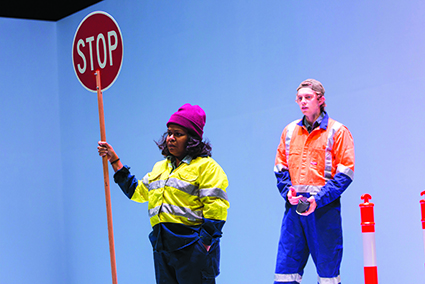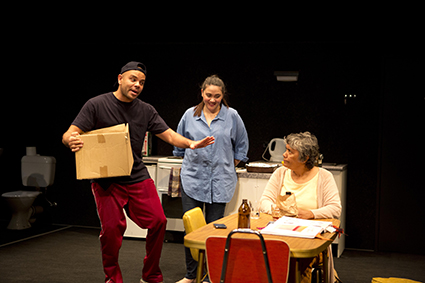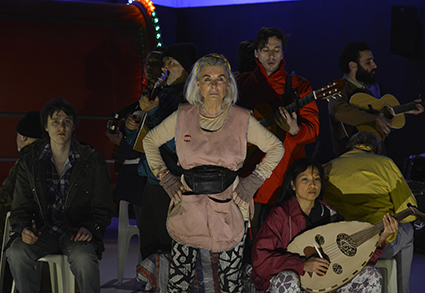Culture and constraint
Keith Gallasch: Sydney Performance

Ursula Yovich, Harry Greenwood, Love and Information, a Sydney Theatre Company and Malthouse production
photo © Pia Johnson
Ursula Yovich, Harry Greenwood, Love and Information, a Sydney Theatre Company and Malthouse production
War in Bertolt Brecht’s Mother Courage and Her Children, obligation in Aboriginal society in Kylie Coolwell’s Battle of Waterloo, the opposition between myth and science in Ryan McGoldrich’s The Great Speckled Bird and fragmented 21st century reality assayed in Caryl Churchill’s Love and Information remind us that we live and breathe culture, that it constrains and only occasionally liberates us.
PACT, The Great Speckled Bird
In The Great Speckled Bird, writer-performer-director-designer Ryan McGoldrich (a University of Wollongong postgrad) dextrously weaves together contemporary mathematics (where an X/Y point can be realised as a “dancing figure,” cosmology (Big Bang, chicken and egg, etc) and his Irish Catholic grandmother’s expansion of the Prometheus myth into parts 2 and 3 featuring birds (because they figure so little in the Bible). With limited means (a microphone and stand which deftly become a bird, automated Weazel Balls minus the weasels, projected charts) and two extrovert musicians (also as birds), McGoldrich quietly engrosses us with an expansive exercise in lateral thought that delightfully and quite personally eases the existential anxieties he initially induces.
STC, Battle of Waterloo
Kylie Coolwell’s The Battle of Waterloo might be conventional, but it is not just another play. The complexity of Aboriginal life in high-rise public housing in Sydney’s Waterloo is vividly and revealingly realised by Coolwell, director Sarah Goodes and a talented cast who perform with verbal and physical verve.
Not only is Coolwell, a Mulinjarlie woman from south-west Queensland and a resident of Waterloo, finely attuned to the communality and ruses of everyday conversation and the wit and economy of Aboriginal English, but she knows how to write dialogue that generates movement. There’s stolid stillness in Shari Sebben’s central performance as Cassie, the older sister sharing responsibility with her aunt (Roxanne McDonald) for her drug-addicted sister Sissy (Shareena Clanton) and young brother Jack (James Slee). But, save for her aunt’s calming presence, the other characters irritate Cassie with a mad dance of comings and goings—the sister demanding money, Jack hiding from his mother, Leon (Leon Simon) on the run and Cassie’s sometime lover Ray (Luke Carroll) back from three years in gaol and brimming over with restless energy, eager for work and a revived relationship. Then there’s the singing along to favourite songs on the radio, a vibrant scene where everyone dances, embracing and cuddling, football play (underscoring the dignity offered men—otherwise deprived of it—by participation in the Indigenous Knockout football round), a police chase and Sissy’s truly frightening drug-induced physical aggression.

Luke Carroll, Shari Sebbens, Roxanne McDonald, The Battle of Waterloo, Sydney Theatre Company
photo Lisa Tomasetti
Luke Carroll, Shari Sebbens, Roxanne McDonald, The Battle of Waterloo, Sydney Theatre Company
Cassie desires a life of her own, as a fashion designer, and knows that she mustn’t be pulled into Ray’s potentially criminal orbit, let alone the escalating demands of her family. Her sense of obligation and, later, guilt threaten to overwhelm her ambition and, above all, her sense of self. Only when everything comes undone, does Sebbens depart from her stable trajectory, unleashing Cassie’s pain—disbelief, denial, loss and guilt—as raw, frantic energy. It’s deeply disturbing and it’s Cassie’s tragedy, not Ray’s.
As true as it can be, there’s an almost melodramatic inevitability to Ray’s demise—one of many defeated, vulnerable young Indigenous men. He dies before he has to face the challenges Cassie represents. In the end, has she been cruelly liberated by Ray’s death or will an unwarranted sense of guilt and familial responsibilities overtake her? That’s where I would have liked Coolwell to take us.
Like Nakkiah Lui (Kill the Messenger, Belvoir, Feb-March, RT126, p32), Kylie Coolwell writes with impressive ease, wit and insight if with a vision more nuanced and expansive. Sarah Goodes’ taut direction yields a great sense of community as well as anxious momentum. Renee Mulder’s design captures something of the dark density and height of the housing commission tower, if looking generously spacious. Cassie’s fashion design, a critical element, disappointed, let alone needing a few other pieces and signs of her work.

Robyn Nevin and cast, Mother Courage, Belvoir Theatre
photo Heidrun Löhr
Robyn Nevin and cast, Mother Courage, Belvoir Theatre
Belvoir: Mother Courage and Her Children
Eamon Flack’s Mother Courage for Belvoir is Brechtian by the book but lacks the dynamic of tough intellect and emotional passion that might make it work in a culture like ours, often indifferent to the endless wars being enacted around the globe and their refugees. It’s a no-risk production, subtle in actorly detail—excellent for close-ups were it film—light-on musically and determinedly ordinary in appearance with its ‘we’re not having a set’ design and its ragbag of daywear costumes. This postmodern liminal ‘we’re not anywhere in particular’ universalism tells us nothing in a period of horrendous specificities. Nor is anything added by translator Michael Gow’s light dusting of the text with Australian English.
Brecht’s play warrants a production with gravitas, which when savagely undercut will catch us out politically as we swing between empathy and repulsion. From that should come a vision that is not simply a humanistic ‘people are like that’ response. Robyn Nevin’s Mother Courage is finely realised if not allowed great scope while Anthony Phelan as the Chaplain, who learns that he has become a better person the worse the circumstances, and Emele Ugavule as the mute Kattrin provide some of the emotional intensity which is otherwise intermittently felt from an essentially strong ensemble. These are not the times for a low church, user-friendly, Marxist-lite Mother Courage. And, lest we forget, Brecht wrote a tragedy.
STC: Love and Information
Kip Williams’ realisation of Caryl Churchill’s Love and Information is a far more disorienting experience if likewise short on extremes, so that the whole is more dream than the nightmare it could be, a condition exacerbated by having a small cast who quickly grow more familiar than would the at least 16 or many more actors that Churchill prefers. For a play so alert to the byte-size realities of the digital age, Williams’ production is charmingly ‘analogue.’ The design magic required to manage the huge number of brief scenes and segues is realised by the actors, tightly choreographed, sliding large blocks around the white-box stage into ever new permutations—from museum plinths to swimming pool to cemetery—and by the dextrous lighting, with its eerie pastels.
Churchill has provided director and actors with exquisitely crafted short, context free, realistic monologues and dialogues without character designations but with a disruptive, Zen-ish acuity of observation. The playwright has patterned her micro-fictions but allows the makers of her work freedom to cluster and juxtapose many of them. In this production, for example, there’s an unnerving series focused on memory (a key subject overall): someone whose memories are solely of television shows; another whose pop culture recall is astonishingly precise; a post-coital pair of ex-lovers whose recollections of their time together are totally out of synch; a woman who uses a Renaissance technique to organise her memory and suddenly has an unsettling vision of her father in a dressing gown when she was four (and she can see her own feet); a severe dementia patient who can’t speak but plays the piano; and someone who can’t shake a traumatic event. Other scenes focus on delusions: a roadworker who hears God is asked, “Does he speak with an English accent.” A man who receives messages via traffic lights in reminded that he’s ill. Another is castigated by his partner for having virtual sex: “She’s just information.” “But the sex is great,” he retorts. Elsewhere information is enigmatic; a woman going into hiding is told, “You’ll find you can feel when it’s raining.” There are passages about gene science, evolution and metaphysics (to which a worker retorts, “I don’t mind not meaning anything).”
Towards the end of Love and Information, Williams’ ramps up the intensity—an astronaut appears (to prog rock accompaniment), red flowers add alarming colour to a funeral in falling snow (“He must have been everything to you.” “I don’t know. We’ll see”). Barely explicable violence is enacted on a man whose only difference appears to be his affection for a stone. It’s not as if Williams is attempting to make one big conceptual picture (the modular set design offers the requisite cogency); that would, first, deny the audience the opportunity to step back and see more clearly what we are faced with every day in our culture and, second, limit the work we have to do to read the thematic threads of Churchill’s writing inventively realised by director and actors.
This production doesn’t electrify, as one feels it should, but it serves as an admirable introduction to the play, if only more companies would commit to playing more Caryl Churchill in Australia.
Love and Information is an important play that not only reflects the fragmented nature of our culture but also refuses to engage conventionally with the issue. Instead it makes sense of and takes advantage of that fragmentation by offering theatre artists, and thereby the audience, the opportunity of a grand collaboration.
PACT, Afterglow season: The Great Speckled Bird, direction, design, text, performer Ryan McGoldrich, performers, music Claire Stjepanovic, Steve Wilson-Alexander, PACT, Sydney 17-20 June; STC, Battle of Waterloo, writer Kylie Coolwell, director Sarah Goodes, design Renee Mulder, Wharf 1, 5-27 June; Belvoir, Mother Courage and Her Children, writer Bertolt Brecht, director Eamon Flack, designer Robert Cousins, from 10 June-26 July; STC Love and Information, writer Caryl Churchill, director Kip Williams, design David Fleischer, lighting Paul Jackson, Wharf 1, Sydney, 9 July-15 Aug
RealTime issue #128 Aug-Sept 2015 pg. 34-36






